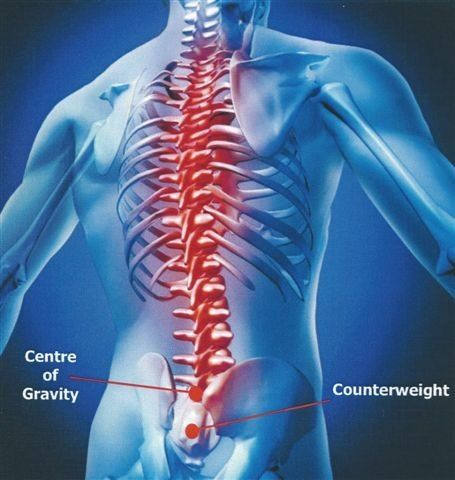
Posteriorly; the external occipital protruberance, the seventh cervical spinous process, the fifth lumbar spinous process, the first sacral median crest and the gluteal crease.
Laterally; the external auditory meatus, the sulcus intertubercular of the humerus, the greater trochanter of the femur, the anterior proximal tibiofibular joint and the talocalcaneal sulcus.
The Physiological Efficient Posture is this optimal position.
It is the posture in which the body uses the least amount of energy to maintain its uprightness within the gravitational field. You probably see it in your practice rooms every day; not in your clients or even, dare I say, colleagues, but on the anatomical charts you have on the wall.
If you exhibit the Physiological Efficient Posture then when you are standing at a plumb line, from behind the string would bisect you equally left to right and your shoulders, hips and occiput would be level and parallel. From the side the string would pass through the middle of your ear, shoulder, hip, knee and ankle and the spinal curves would be smooth and normal.
Every object has a centre of gravity. This is the point at which the combined mass of the body appears to be concentrated. If that point is over the centre of support, which is called the counterweight, then the object will just simply balance.


How can the centre of gravity be in the same place for everyone when people come in all different sizes?
The centre of gravity of an object is defined as a point at which the whole weight of an object can be considered to act from and, therefore, at which all parts of the object are in balance.
In static objects of uniform density and shape the centre of mass and the centre of gravity are the same point. However, in dynamic biological systems they are not.
So the answer to the question above is that what we think of as the centre of gravity is really the centre of mass, and indeed the centre of mass of an individual does depend on their body shape and size.
The centre of gravity of humans is where the whole weight of the body is considered to act from and the biomechanics of the upright body dictate that this is just anterior to the L5/S1 junction.(1) The whole weight of the upper body has to be transferred to the Earth via the L5/S1 disc, the sacrum, the sacroiliac joints, the legs and finally the feet.
For every action there is an equal and opposite reaction. This means that there must be an opposing force coming up from the Earth to balance the gravitational pull, and in fact there is. It is called the Ground Reaction Force and it holds us up against the pull of gravity. It travels the reverse path of gravity; up through the feet, the legs, the sacroiliac joints and the sacrum.
However, the Ground Reaction Force comes to a focus at the centre of gravity of the sacrum, which is at the third sacral segment, and not at the L5/S1 junction. This forms a counterweight to the centre of gravity.
A counterweight is defined as a force or influence that balances or equally counteracts another?
Because the counterweight and the centre of gravity are not at the same point a degree of instability exists. Some people feel that the reason that this has come about is that our basic anatomy developed when we were quadrupeds and has been adapted, but not altered, to our bipedal gait.
This instability was called the loose link by John Hurley and Helen Sanders.(2)
The first thing that happens is that the paraspinal muscles will tighten to hold the body upright against the pull of gravity. These then recruit the larger postural muscles to help them. This gives rise to the postural compensation patterns we see in our practice rooms. Over time this stress leads to strain, distortion, pain, disease, exhaustion and ultimately death.

A study in 1998 demonstrated how important posture and the rehabilitation of posture are to the reduction of symptoms presented by clients. It showed that poor posture leads to poor healing of body tissues and can lead to pathological postural changes as shown in the above diagram. It also showed that a reduction in symptoms is not enough of a guideline in measuring the improvement in the structural load on the human frame.(3)
This has implications for you if you are involved in addressing people's joints, muscles, fascia, posture, energy blockages, wellness or peak performance.
When joints misalign the body has its own self correcting mechanisms. In the case of the vertebrae the body will use the paraspinal muscles to make the correction, rather like the guy ropes of a tent or mast. If those muscles are too busy holding you up against gravity they can't be flexible enough to correct the misalignments. A similar argument applies to all other joints of the body.
Muscles
If muscles have been recruited to maintain an upright posture against the pull of gravity then so long as those holding patterns have to remain any muscle release techniques won't be able to remove all the tension in those muscles.
Fascia
Fascia is one continuous sheet throughout the body. If the fascia has compensated for postural distortion, for example the dura mater when the Primary Alignment is lost, then fascial release work anywhere in the body will be impaired because of the torsion remaining in the dura mater.
Posture
If you are trying to improve someone's posture with education or exercise techniques then while the Primary Alignment is displaced it will make it much more difficult to achieve lasting change.
Energy
It will require much more work applying energy techniques if the energy channels within the body are blocked due to postural distortion.
Wellness
If you are working to promote wellness within a distorted body then there are going to be several factors which will reduce the effectiveness of wellness education.
- Breathing. When there are postural distortions the respiratory diaphragm is adversely affected reducing a person's vital capacity.
- Circulation and lymphatic drainage. With the diaphragm distorted you get impaired venous and lymphatic return as the inferior vena cava is not "milked" superiorly on inhalation. This can lead on to passive chronic venous congestion and lymphodoema.
- Visceroptosis. With an anterior lean of the body you can get a sagging of all the internal organs making it much more difficult for an organ to function properly and to act in concert with the other organs.
- Biochemistry. Postural distortion can lead to changes to the biochemistry as homœostasis has to convert to allostasis.
When concerned with attaining peak performance in a sport, creating marginal gains can make all the difference. The restoration of the Physiological Efficient Posture is a marginal gain often overlooked.
Consider the following ...
The following extract refers to a physical body when it is in the Physiological Efficient Posture.
Attributed to Roger Sperry, PhD.
Medical Nobel Prize winner for
brain research, 1981.
If we look again at the passage from Roger Sperry we can see that just under 10% (let's call it 10% from here on in) of the total output of the brain is used for thinking, metabolism and healing.
Just think about that for a minute. 90% of the total output of the central nervous system is used for keeping our bodies upright in the gravitational field and only 10% for everything else.
Only 10% of the output of our central nervous system is available for digesting our food, making new body parts, composing symphonies, being good at sums, restoring, renewing and repairing ourselves, loving our families and friends, being creative, reading this article, and in fact any other activity you can possibly think about, including being "Faster, Higher, Stronger"!
Obviously we need to keep that 10% working so that we can reach our full potential in life.
That means even less of that all-important 10% is available for everything else, or, as Roger Sperry said,
"The more mechanically distorted a person is, the less energy available for thinking, metabolism and healing"
Obviously the key to abundant energy is to keep the body in its Physiological Efficient Posture.
Neurological studies have shown that for the homeostatic pathways within the brain to be functioning optimally then we need to have a Physiological Efficient Posture. This is owing to the fact that the vast majority of the proprioceptors are located within the spine and the stimulation of these is responsible for the stimulation of the homœostatic regulatory centres within the brain. So, the movement of a distortion free spine with exercise is essential for more energy being available for thinking, metabolism and healing.(4) & (5)
Core Postural Alignment, helps the centre of gravity to return to its correct relationship with the counterweight, and so restores the Physiologically Efficient Posture.
A Core Postural Alignment session starts with a simple yet quantifiable postural assessment using a plumb line. Once it has been established in which precise way the centre of gravity is displaced relative to the counterweight then a neuromuscular holding point can be determined, which will restore that relationship.
The recipient lays prone while an alignment is given. An alignment consists of maintaining a contact on the relevant neuromuscular holding point while releasing the persistent distortion patterns in the major postural muscles. This uses a unique finger-tip pressure to gently massage them. In fact once you have contacted the integument under the skin the pressure used is only five grams.
Following this a post-alignment assessment is done and the improvement can be instantly measured and recorded. A pre-assessment, an alignment and a post-assessment takes between ten and fifteen minutes so they can easily be added into your treatment protocol; allowing your existing skills to become that much more effective.
The Benefits
Joints can be re-aligned more easily as you are not working against the paraspinal muscles. Muscle release techniques are more effective as the larger postural muscles can release the holding patterns they have had to adopt. The twists and restrictions in the fascia are more easily removed as there is less postural disturbance to the fascial system holding them there. Postural improvements are easier to make as the body isn't trying to avert collapse. As the energy channels of the body are lined up then the body will accept energy input techniques more easily. Wellness will be enhanced because of increased vital capacity, improved circulation, lymphatic drainage, a decrease in visceroptosis and a return to homœostasis. Peak performance can be improved as marginal gains are increased.
References
- Hurley, J. & Sanders, H. Aquarian-Age Healing For You. Book Two, 1933, pg. 147
- Hurley, J. & Sanders, H. Aquarian-Age Healing For You. Book Two, 1933, pg. 149
- Troyanovich et al. Structural rehabilitation of the spine and posture: rationale for treatment beyond the resolution of symptoms. J Manipulative Physiol Ther. 1998 Jan;21(1):37-50.
- Schmahmann, J. From movement to thought: Anatomic substrates of the cerebellar contribution to cognitive processing. Human Brain Mapping 1996 (4)
- Jensen, E. (2000) Moving with the Brain in Mind Educational Leadership November, Vol. 58, No.3, pgs. 34-38, ASCD. Alexandria, VA
Bibliography
- Aquarian-Age Healing For You, Book One. John Hurley, D.C., Helen Sanders, D.C., Ph.C.
- Aquarian-Age Healing For You, Book Two. John Hurley, D.C., Helen Sanders, D.C., Ph.C.
- Essentials of Body Mechanics in Health and Disease. Fourth Edition. Goldthwaite M.D., F.A.C.S., LL.D, Brown M.D., F.A.C.S., Swaim M.D. and Khuns M.D., F.A.C.S.
- Clinical Biomechanics: Musculoskeletal Actions and Reactions. Second Edition. R.C. Schafer, D.C., Ph.D.
- Innate Physical Fitness & Spinal Hygiene. James L. Chestnut, B. Ed., MSc., D.C.
